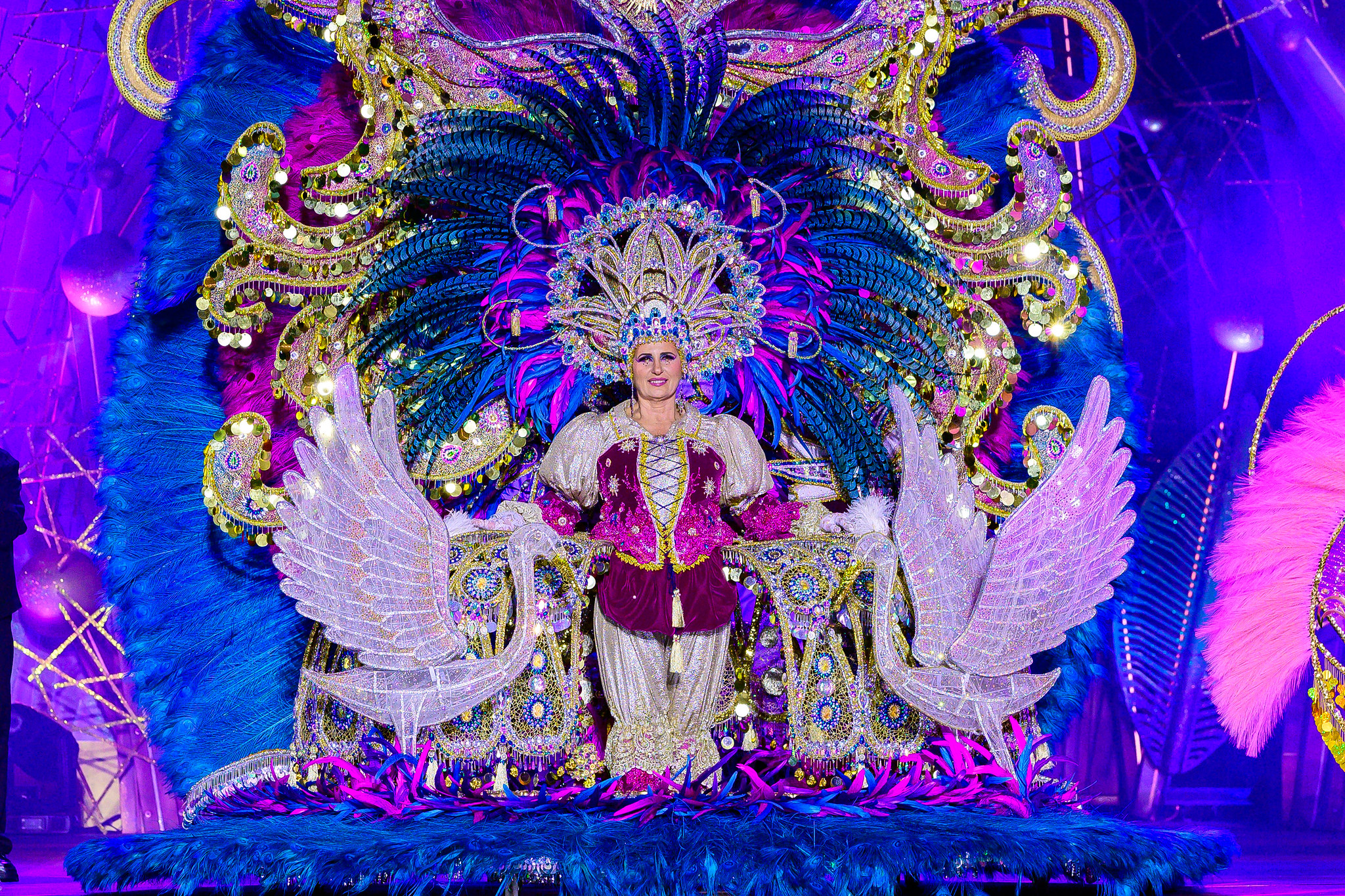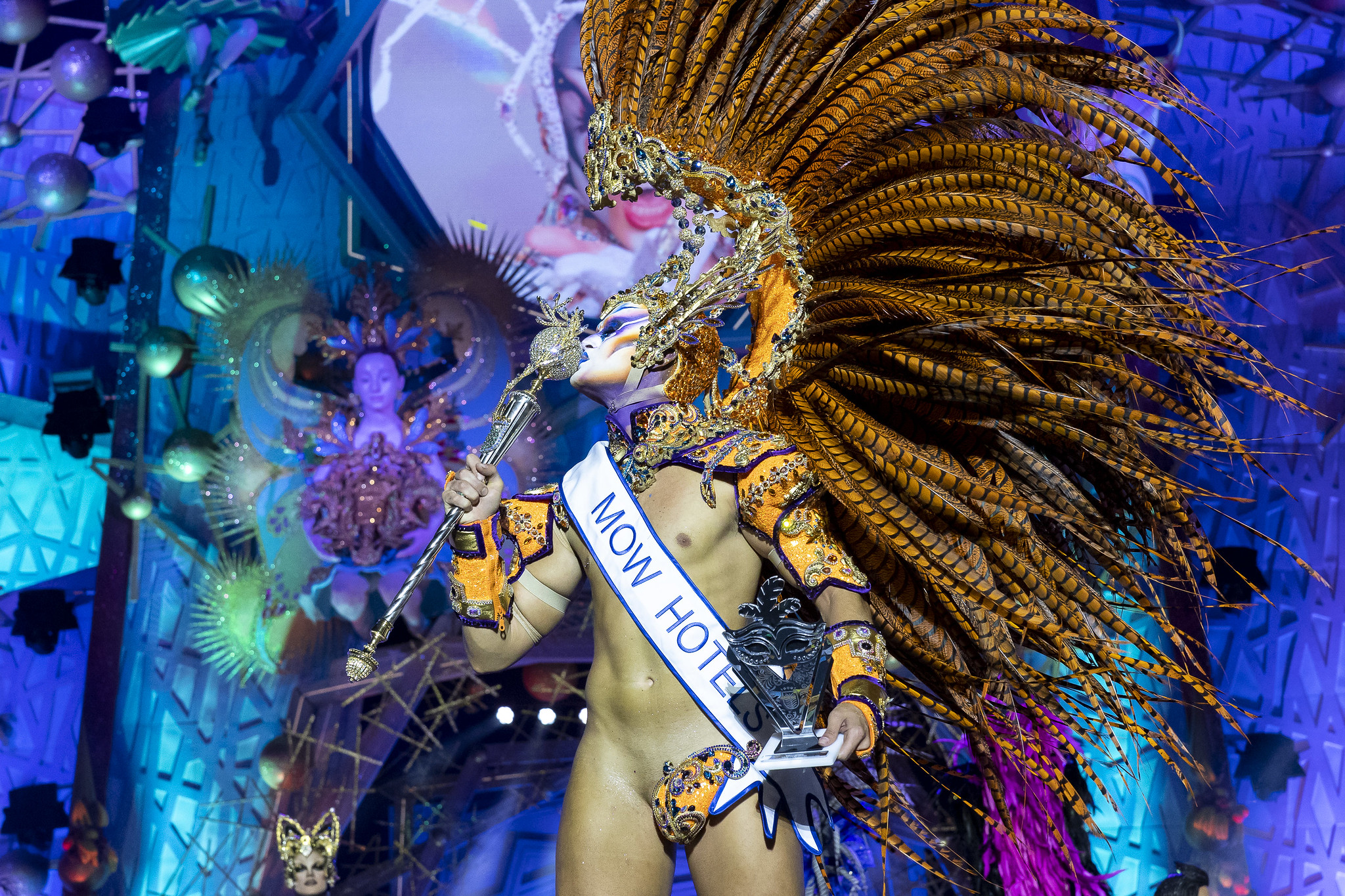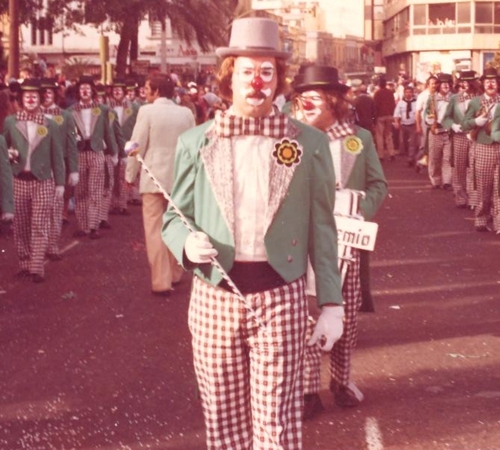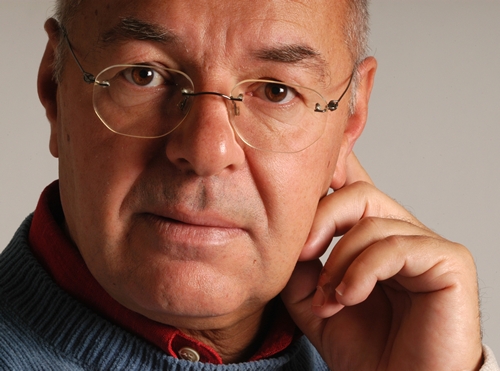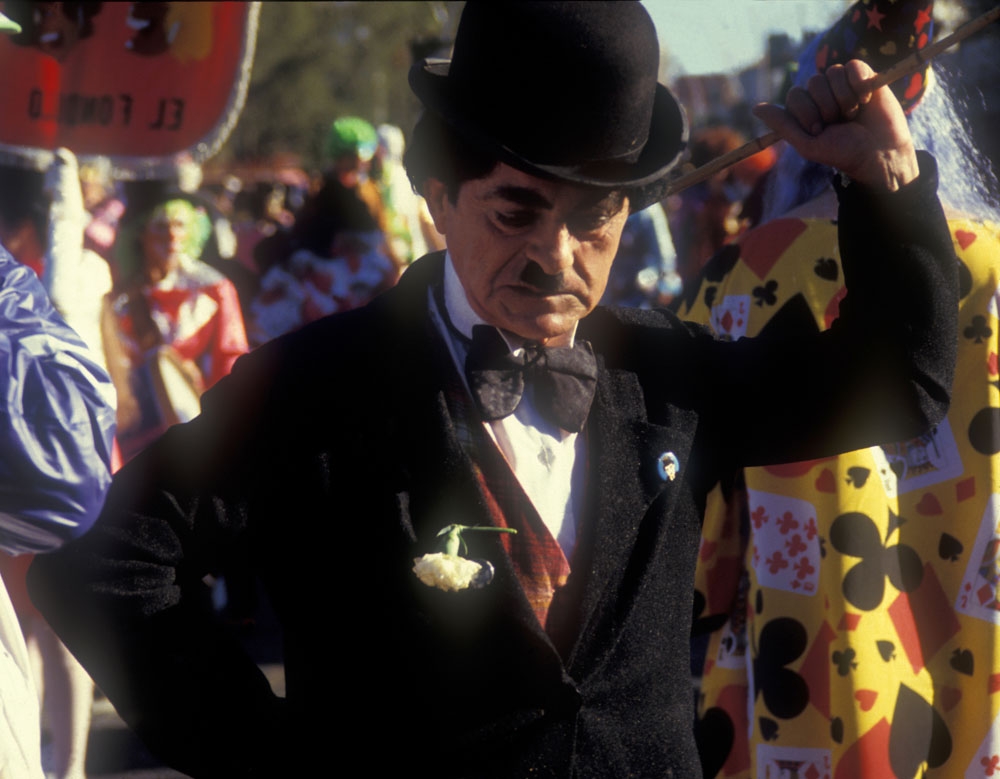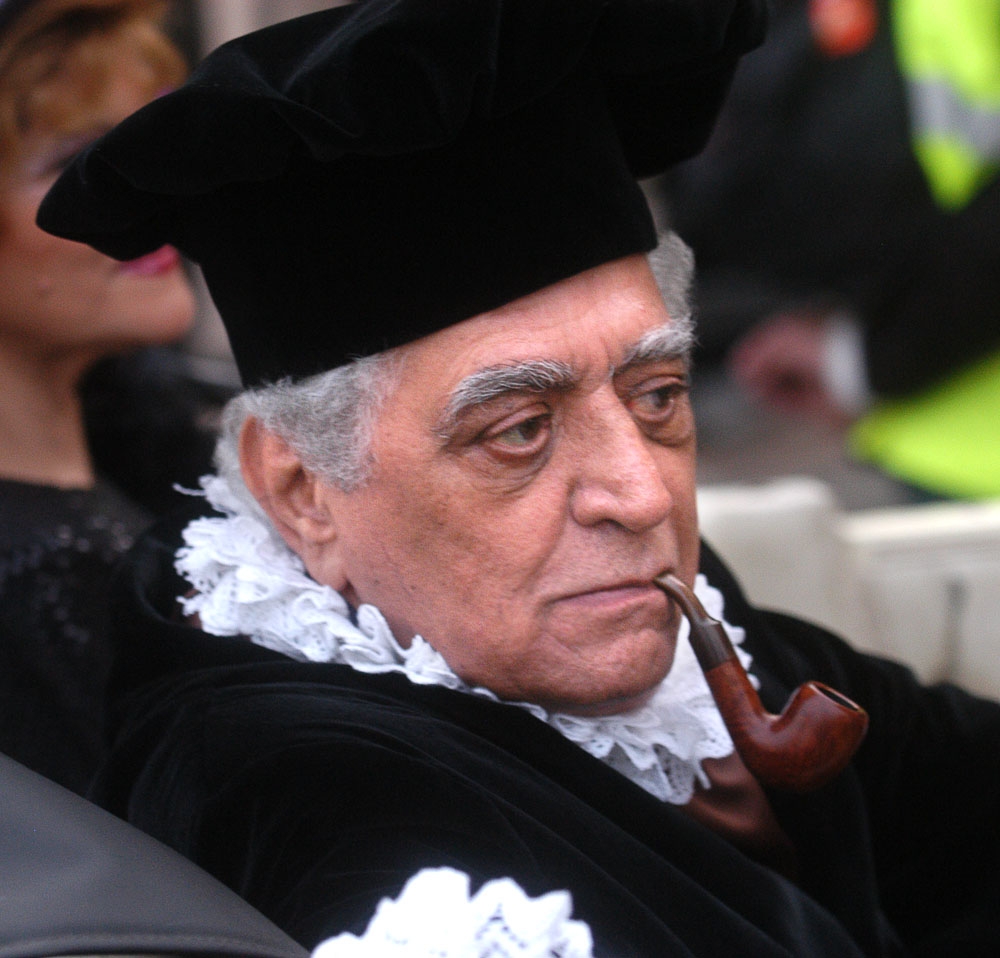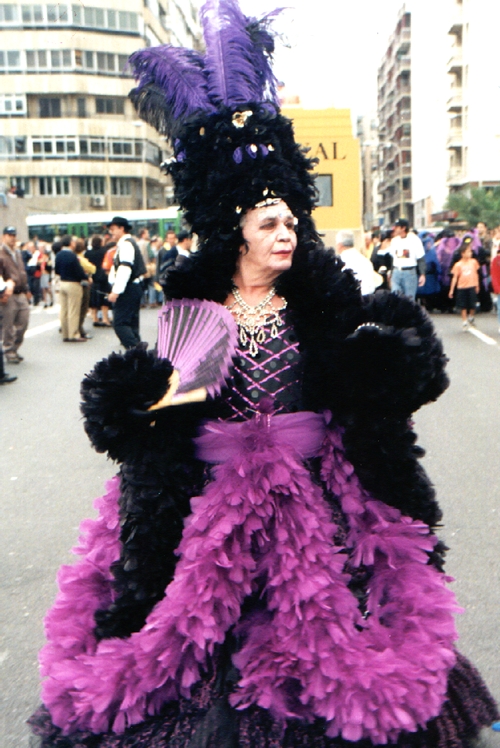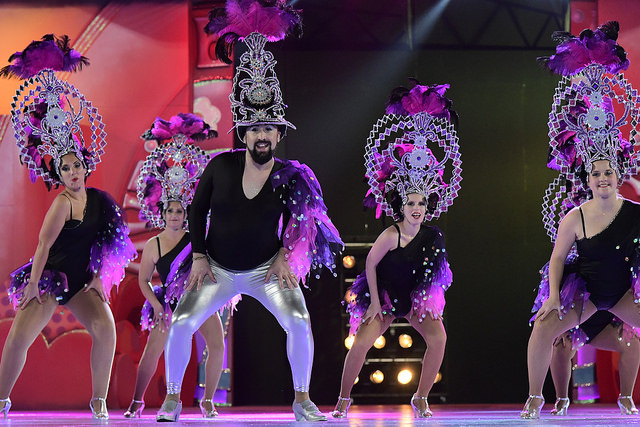Eva Costa Santiago
Eva Costa Santiago received the title of the Carnival Grand Dame. For a whole year she will show off a reign which she achieved thanks to the Light of the Adriatic costume designed by Isidro Pérez Mareo and Daniel Rivero Suárez in representation of the Ciudad Alta District.
Katia Gutiérrez Thime
Katia Gutiérrez Thime was crowned queen of the “Carnivals of the World” under the affectionate gaze of her predecessor, Lola Ortiz, and that of the queens of great and renowned carnival celebrations: Rio de Janeiro, Venice, Barranquilla and Santa Cruz de Tenerife: it was a historic occasion for all of these queens to gather together in the Gran Canaria capital.
The ”Midas’s Treasure” costume, designed by Manuel Encinoso and sponsored by Dormitorum, fulfilled the prophecy and took Katia directly to the throne.
Drag Elektra, Iván Sánchez Pérez
It was third time lucky: Drag Elektra became the Drag Queen of Las Palmas de Gran Canaria on the third try. She did it with the show entitled “It’s outrageous”, sponsored by MOW hotels, with a design by Nancy Henríquez González, and she achieved the prize exactly ten years after competing for the first time: her first attempt, in 2014, didn’t reach the classifying round, and in 2019 she got through the pre-selection.
The hum of the presentation of her fable in the classifying stage must have been convincing because even before her number began, the ovation made itself heard in the Belén María venue, to the extent that the other contenders chanted her alias right before the name of the 2024 Drag Queen was revealed. Days earlier, in the classifying stage, Elektra had won the special jury’s prize for the best costume design.
Tomás Pérez
Tomás Pérez is considered one of the Carnival's best lyricists and many people speak of him as the father of Gran Canaria's Murga style. As well as being the founder and director of the Afilarmónica Los Nietos De Kika, from Arucas, he set a style and his good work encouraged the creation of Murgas in many of the Las Palmas de Gran Canaria quarters, with his lyrics packed with irony, criticism and pasodobles.
He died on 29 February 1996, shortly after the Carnival "sardine's burial" (final act on Ash Wednesday) for that year. Since then, the Carnival awards the Tomás Pérez Prize for Best Lyrics during the Murga contest in memory of this great Murga artist.
Sindo Saavedra
Sindo Saavedra, a composer, supporter of popular arts, painter and playwright, was the author of the Las Palmas de Gran Canaria Carnival Anthem.
He was born in Las Palmas de Gran Canaria and he also died here, very close to the sea and the beach which he loved so dearly, Las Canteras. From a young age he came into contact with the current cultural movements, and he lived in cities such as Malaga, Paris, Chicago and in countries such as Germany and Italy. On his return to Gran Canaria, his work in composition, research and the preservation of music and dance from the Canarian archipelago was recognised at all social and cultural levels.
From his work, one of the best known pieces is the Las Palmas de Gran Canaria Carnival Anthem: under the title of Ponte Tu Mejor Disfraz (Put On Your Best Costume) it has been like a letter of introduction to the Gran Canaria capital's most international and best-known fiesta. Sindo used to say that music in the Carnival justified dressing up.
He was hugely fond of his city and of his native land, and his work is steeped through and through with his values regarding freedom, social commitment and the environment.
Santiago García, Charlot
Santiago García Díaz, the Las Palmas Carnival Charlot (Charlie Chaplin), was a man who always stood out for his humanity, charm and charisma. He was born in Santa María de Guía, in the north of Gran Canaria, and he always took part in the festivities, even in the era when they were banned. In 1976, with the start of the official Carnival celebrations, he started to dress up as Charlie Chaplin, a personality whom he admired and respected, second to none. Dressed like that, always with his stick, his bowler and his bow tie, and his peculiar gait, he used to walk up and down the streets of the city, greeting the ladies like a true gentleman, full of tenderness towards the little ones and, above all, making everyone laugh.
He died in 2001 at the age of 73, just a few days after the end of that year's Carnival. The Carnival groups and the personalities from the fiestas went to bid him farewell, all in their costumes as he himself always used to say "may my funeral be a party full of Carnival party-goers looking to have a great time".
Manolo García
Manolo García is considered to be the father of Carnival in its modern incarnation in Las Palmas de Gran Canaria.
In 1976, a few months after Franco's death, Manolo García, originally from the La Isleta quarter, telephoned the province's Civil Governor and got permission for the Carnival celebrations to return to the city's streets after 40 years of prohibition.
He was born in 1934 in Pérez Muñoz Street. Having been a trader in shady deals, a neighbourhood leader, and presided over cultural and sporting associations, he decided to set what he himself termed the most difficult project of his life going.
The greatest publicist of the Carnival took any chance that offered itself to demand that the celebrations should reach out to everyone and he always tried to get absolutely everyone involved.
The Carnival organisation has been awarding the Manolo García Trophy since the 2010 Carnival.
Juanito el pionero
Juan Curbelo, Juanito el Pionero, became one of the best loved characters in the Las Palmas de Gran Canaria Carnival. He was one of the pioneers, of the first people to hit the streets in fancy dress. His personality and the way he celebrated the Carnival festivities made him one of the most original representatives of Carnival at ground roots level. And with his particular way of interpreting the celebrations, he always said he considered himself to be the First Drag Queen of the festivities.
Good cheer just poured out of him. All the same, he had a very hard time as a young man. During the Franco dictatorship, he was locked up in the what was known as a correction centre for the reeducation of homosexuals in Tefia on the island of Fuerteventura. Juan Curbelo belongs to the first generation of gays who were imprisoned for their sexual orientation. At the age of 16, he refused to renounce his homosexuality and his stay turned into a cruel sentence which did not, however, ever take away his eagerness.
Araguimé
First Prize for Performance in 2003, 2005, 2006, 2008, 2010, 2011, 2012, 2014 and 2015 for the show "A Ritmo de Carnaval" (To the Beat of Carnival)
First Prize for Costume 2010, 2011, 2012, 2013, 2014, 2015, the latter being for the costume "Amanecer en Arabia" (Arabian Dawn)
Bahía Tropical
Bahía Tropical, presided over by Carmen Guillén, went on stage of the Grand Masked Dance Carnival in 2013.
Rafaela Dámaso took over as director of the group in 2015 and in 2017 she became the group’s new president.

